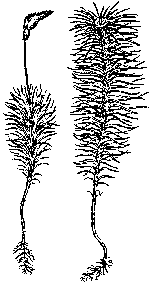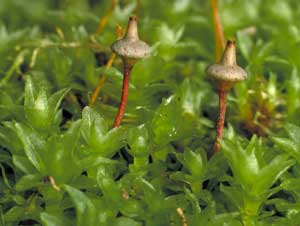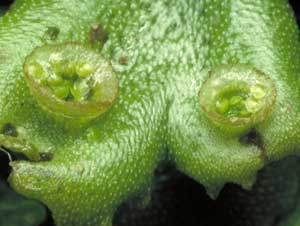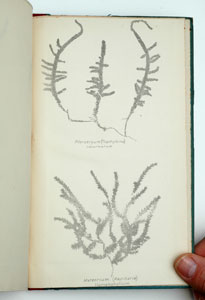|
Episodes in Australian bryology
The first century
Australian bryology began in the 1790s with the first collection of bryophyte specimens from Australia and the 1800s saw European botanists publishing accounts of the species to be found in Australia. At first bryophytes were collected by visiting naturalists but the later years saw much collecting by residents. However, even approaching the 1900s specimens were sent to Europe for study with the results being published in European botanical journals.
The earliest years
Despite earlier British botanizing in Australia, the first bryophyte collections definitely known to have come from Australia are those of the French naturalist Jacques-Julien Houtou de Labillardière (1755-1834). It was once thought that William Dampier had collected a bryophyte in Australia in 1699, but an examination of that collection has shown the Australian provenance to be very unlikely. The details are in the DAMPIER'S LEUCOBRYUM CASE STUDY. Labillardière travelled with the D'Entrecasteaux expedition of 1791-1794. In the second volume of his Novae Hollandiae Plantarum Specimen, published in 1806, Labillardière described and illustrated two moss species (Leskea pennata and Hypnum comosum) and one liverwort, Jungermannia flabellata, though the last was listed under the Algae. The illustration of Hypnum comosum appears at the top of this page. The specimens were collected in Tasmania and he described all three as new species, though later research has shown that Labillardière's "new" species Leskea pennata was already known under another name, but the other two were not previously known. Changes in bryophyte taxonomy since Labillardière's time has led to new names for all three bryophytes. Today the mosses are known by the names Cyathophorum bulbosum and Hypnodendron comosum, while the liverwort is now Hymenophyton flabellatum ![]() .
.
The British botanist Robert Brown (1773-1858) accompanied Matthew Flinders on his 1801-1803 voyage in HMS Investigator to chart the coast of Australia and Brown remained in Australia until 1805. Between 1801 and 1805 Brown collected several thousand plant specimens, including a small number of bryophytes which are now held by the Natural History Museum in London. In a letter that Brown wrote in Sydney in 1805, to accompany a box of specimens and seeds he was shipping to Sir Joseph Banks, Brown noted:
A species of moss; in habit, double calyptra and disposition of male flowers exactly a Polytrichum, but differing so widely in its peristoma, both from a Polytrichum and every other moss, that it will, according to the principles on which genera have lately been establish'd in this order, constitute a new one.
|
Brown followed-up on the sentiment expressed in this letter and, in 1811, published the description of a new genus, Dawsonia. The moss mentioned in the letter became Dawsonia polytrichoides, the name by which it is still known today. The species is endemic to eastern Australia but some other species in the genus are found in Malesia. In the same paper Brown established a second new moss genus, Leptostomum with four species, two from Australia: Leptostomum inclinans and Leptostomum erectum. The paper contained drawings showing the features of Dawsonia polytrichoides and Leptostomum inclinans.
In 1810 Brown had published the first of two proposed volumes of Prodromus Florae Novae Hollandiae et Insulae van-Diemen, an account of the Australian flora. The first volume contained about 450 pages and documented the Australian ferns and flowering plants. The second volume was to have included the bryophytes as well as various other subjects. Brown had estimated that the second volume would need 144 pages and, as it logically preceded the first, the first page in the first volume was numbered 145. Brown published the 1810 volume at his own expense but when it failed to sell well he withdrew it from sale after only 26 copies had been sold and the second volume never appeared. Brown contributed a botanical appendix to the second volume of Matthew Flinders' account of the Investigator expedition, A Voyage to Terra Australis, published in 1814. The list of bryophytes in that appendix noted 25 mosses, 13 liverworts and one hornwort but with mention of neither Dawsonia nor Leptostomum. The list is just that, a list, with no record of where the species had been found. In later life Brown became the first Keeper of the Botanical Department in the British Museum, now the Natural History Museum in London, which holds Brown's Australian bryophyte collections![]() .
.
The later 19th century
In the early years of the European settlement of Australia the most significant botanical collecting was carried out by visiting botanists, such as Labillardière and Brown. Another example, less than a decade after Brown, was the French botanist Charles Gaudichaud-Beaupré (1789-1854) who visited Australia with the Freycinet expedition of 1817-1820 and collected a small number of Australian bryophytes. He published a report of his bryophyte collections in 1826 in the botanical part of Freycinet's account of the voyage. The moss Leptotheca gaudichaudii was named after Gaudichaud-Beaupré by the German botanist Christian Friedrich Schwaegrichen (1775-1853) and the original description, published in 1824, was based on specimens collected by Gaudichaud-Beaupré at Port Jackson in New South Wales.
The first few decades of the 19th century saw no comprehensive account of the bryophytes of any region in Australia. The number of specimens available for examination was simply too small to allow such a study. The Australian flora in general had excited the European botanists, since Australia produced numerous new species and genera, all of which had to be examined to see how the Australian plants were related to those from elsewhere in the world. Naturally the Australian bryophytes, though small in number, were similarly assessed and included in broader accounts. For example, the Swiss bryologist Samuel Elysée Bridel-Brideri (1761-1828) included the known Australian species in his two-volume survey of the world's mosses, Bryologia universa seu systematica ad novum methodum dispositio, historia et descriptio omnium muscorum frondosorum hucusque cognitorum cum synonymia ex auctoribus probatissimis, published in 1826-1827. As well as the scientific Latin names, Bridel-Brideri (unlike most writers) also gave "common" names, in German, French and, occasionally, English. Some were well-established and widely used by people in general, but others were clearly artificial. That was especially the case for common names, in German and French, for species known then only from Australia. There's more in the BRIDEL-BRIDERI CASE STUDY.
By the mid-19th century a number of European settlers were taking interest in the Australian flora and had been making significant collections of plants in general for despatch to European botanists. Amongst those were many collections of bryophytes. Throughout the 19th century and even into the early 20th century the bulk of studies on Australian bryophytes were published by European bryologists. Initially the great majority of specimens were sent to British institutions because of the strong connection between Australia and Britain in colonial times. Later many specimens were sent to bryologists in several continental European countries.
William James Hooker (1785-1865) and his son Joseph Dalton Hooker (1817-1911) were two of the major botanists of the 1800s. The elder Hooker became director of the Royal Botanic Gardens at Kew, in London, in 1841 and at his death was succeeded by his son, who remained director until 1885. The Hookers built up a large group of plant collectors resident in many parts of the world. The elder Hooker published a two-volume work, Musci exotica; containing figures of new or little known foreign mosses and other cryptogamic subjects, published between 1818 and 1820. The work contained descriptions, detailed drawings and brief comments about various mosses and, despite the title, some liverworts as well. A small number of Australian species feature in the volume, including some collected by Robert Brown but not published by him. Illustrations of a few more Australian bryophytes appeared in 1840 and 1845 in the elder Hooker's series Icones Plantarum; or Figures, with Brief Descriptive Characters and Remarks, of New or Rare Plants, Selected from the Author's Herbarium. The younger Hooker participated in several expeditions to widespread parts of the world. He visited Australia during the 1839-1843 southern hemisphere journey of the ships HMS Erebus and HMS Terror. In the course of the journey, the younger Hooker spent six weeks in Tasmania in 1840/1841 and visited Sydney for three in 1841. In Tasmania he collected with Ronald Campbell Gunn (1808-1881). Gunn was one of the Hookers' correspondents, had been born in South Africa and arrived in Tasmania in 1830. Gunn was a prodigious collector of plants and fungi and various species have been named in his honour. An example is the endemic Tasmanian moss Tayloria gunnii. Another significant collector of Tasmanian bryophytes, and a contemporary of Gunn's, was William Archer (1820-1874). He practised as an architect but had a great interest in botany.
There were several other Tasmanians who had been collecting bryophytes during their botanical excursions. The collecting efforts of the resident Tasmanians and the younger Hooker led to the accumulation of a goodly number of specimens from Tasmania. As a consequence the first detailed regional study of bryophytes in Australia was of the Tasmanian bryophytes. The botanical results of the Erebus/Terror expedition were published in several parts with the collective title The Botany of the Antarctic Voyage. The Tasmanian flora was documented in Flora Tasmaniae, published in 1860 as Part III of the series and dedicated to Gunn and Archer. The Flora Tasmaniae made use of the material gathered by Hooker and the Tasmanian collectors. The section dealing with bryophytes was written by the British bryologists William Wilson (mosses) and William Mitten (liverworts and the one hornwort) and the volume notes about 250 mosses and 125 liverworts. The work contained descriptions and illustrations of many species described as new, though later research has shown that a number of those new species were not warranted. The Flora Tasmaniae brings together more than just information gathered during the Erebus/Terror expedition and so presents the mid 19th century level of understanding of the Tasmanian flora. William Mitten (1819-1906) was one of the leading bryologists of the 19th century and published numerous papers about the non-European bryophytes. In particular he worked through many of William Archer's collections. After Mitten's death the New York Botanical Gardens bought his collections. The elder Hooker encouraged William Wilson's (1799-1871) botanical interests. Wilson devoted himself to the study of mosses and became a recognized authority on those plants.
The Scotsman James Drummond (1784-1863) arrived in Western Australia in 1829 from Ireland where he had been curator of the Cork Botanical Gardens. He collected widely in south-western Western Australia and sent his collections to the Hookers in London. Drummond was more than just a collector. He took note of what he saw and included numerous observations in his letters to the Hookers. In one of those letters he expressed his thanks for being sent a microscope and wrote that it...
...has enabled me to detect a little Moss, which has given me more pleasure than anything I have found since the days of my discovery of Hookeria laete-virens, near Cork in Ireland. This minute Moss is not only beautiful in itself, but it affords what I conceive to be an admirable illustration of a subject which it cost me much trouble to elucidate many years ago, namely the germination of Mosses, their first and simplest form, in what I call the conferva state, and ultimately their development into what I term the foliaceous state, being that in which they develop capsules.
Conferva is an algal genus name. What Drummond calls the "conferva state" is the algal-like protonemal stage that is the first step after spore germination, with the leafy gametophyte development growing from the protonema. This is explained in the LIFE CYCLE page. Drummond goes on to say that he had experimented on moss germination many years ago and "...I remember transmitting to you, many years ago, the result of my experiments on the subject, but they appear hitherto to have been little regarded...". The experiments were presumably carried out while Drummond had still been in Ireland, for he also writes of other experiments with mosses, that he did when he was in Cork.
In the letter from which the above extracts were taken, Drummond went on to say that he had enclosed some specimens to illustrate the point he was making about the "conferva state".
Drummond also wrote:
One of the specimens of my little favourite Phascum resembling serratum, you will perceive, is in a more advanced stage. The capsules turn to a beautiful red as they proceed towards maturity, the colouring matter apparently residing in a tessellated membrane which lines the capsule: the veil is open on one side, and beautifully reticulated, as in Hookeria. The confervoid appendages no doubt remain on the plant so long as the perichaetial leaves appear above ground, which in this country is not more than a few weeks.
In one station I have watched the growth of the rare Phascum stoloniferum for several years: I could find the fructification at all seasons. In my opinion, when Mosses are spoken of as annual, the expression only applies to their rising above the soil ... with regard to the articulated filaments which constitute the roots of Mosses, there can exist no doubt that they have the power to produce the species, and for any length of time.
In most mosses the leafy form that grows from the protonema is persistent. However, there are some species, especially of arid areas, where the protonema is persistent and the leafy shoots are ephemeral. These mosses are very tiny and Drummond is undoubtedly referring to some such species, though it's uncertain as to exactly which species he was referring to in that letter. He went on to make the following request of the Hookers:
If you happen to have any living plants of Marchantia polymorpha, I wish you would kindly send me a frond or two, with the cup-bearing sporules, in a letter, I think they would germinate in this country.
The "sporules" he is referring to are the disk-like gemmae that are found in the circular gemma cups in thallose liverworts of the genus Marchantia. Gemmae are a means of VEGETATIVE REPRODUCTION. All of the above shows that Drummond was an intelligently inquisitive observer of the bryophytes![]() .
.
The German naturalist Johann August Ludwig Preiss (1811-1883) collected in the south-west of Western Australia between December 1838 and January 1842. At one time he and Drummond botanised together. Preiss amassed thousands of plant specimens, either collected by himself or obtained from other people. An account of the Preiss plant collections appeared in the two volumes under the editorship of the German botanist Johann Georg Christian Lehmann. The volumes bore the title Plantae Preissianae sive enumeratio plantarum quas in Australasia Occidentali et Meridionali-occidentali annis 1838-1841 and appeared between 1844 and 1847. The second volume contained an account of the Preiss bryophytes and recorded 19 liverworts and 21 mosses. The German bryologist Ernst Hampe (1795-1880) contributed the section about the mosses. For each species there is a detailed description, locality details and a note of the relevant specimen numbers in the Preiss collection. The endemic Australian thallose liverwort Petalophyllum preissii ![]() is named in honour of Preiss
is named in honour of Preiss![]() .
.
Ferdinand von Mueller (1825-1896) arrived in Australia in 1847 and was a pioneer resident Australian botanist. He was the first Victorian Government Botanist, from 1853 until his death. He was a prodigious plant collector and gathered a great many bryophytes from various areas in Australia and also had correspondents scattered throughout Australia who also sent him specimens. Von Mueller relied on European bryologists for identification of the specimens and von Mueller specimens can be found in various overseas herbaria. Those European bryologists published papers in which they documented von Mueller's collections, with many of them described as new species. Some of those species have stood the test of re-examination but others have been found to be simply variants, rather than species in their own right. From time to time von Mueller collated the Europeans' results and published lists of bryophytes recorded from various parts of Australia.
The first report of South Australian mosses was published in 1853, by the German bryologist Carl Mueller (1818-1899) and Ernst Hampe, based on specimens collected by Ferdinand von Mueller.
Paradoxically, von Mueller once described a moss as a new species of flowering plant. The moss Gigaspermum repens ![]() has large spores, over a tenth of a millimetre in diameter, and is widespread in Australia, especially the drier inland areas. The first description of the species had been published in 1819 by WJ Hooker. In 1876 von Mueller published the description of a new species of flowering plant, Trianthema humillima, based on a specimen sent to him from central New South Wales – but this new species of flowering plant has turned out to be the moss Gigaspermum repens. There's more in the TRIANTHEMA HUMILLIMA CASE STUDY.
has large spores, over a tenth of a millimetre in diameter, and is widespread in Australia, especially the drier inland areas. The first description of the species had been published in 1819 by WJ Hooker. In 1876 von Mueller published the description of a new species of flowering plant, Trianthema humillima, based on a specimen sent to him from central New South Wales – but this new species of flowering plant has turned out to be the moss Gigaspermum repens. There's more in the TRIANTHEMA HUMILLIMA CASE STUDY.
|
A small volume entitled Analytical Drawings of Australian Mosses, Fascicle 1 appeared under von Mueller's editorship in 1864. The volume was to have been the first of a series but no further fascicles appeared. The volume contains 20 plates, showing the features of 20 species and part of one of the plates is shown right (click illustration to see full page). The illustrations were drawn in Berlin, under the direction of Ernst Hampe (referred to as Eduard Hampe in Mueller's introduction). Hampe and Carl Mueller were responsible for the identification of the species. The plates were lithographed in Melbourne and the monograph published by the Victorian Government Printer (more examples). In the introduction to the volume von Mueller wrote:
The whole of tropical Australia, with the exception of its eastern forest-mountains, is almost totally devoid of Mosses, but throughout the extratropical latitudes of this continent, with the exception of the most arid desert-tracts, they are more or less copiously distributed; but in the humid and wooded ranges, and especially the ferntree-valleys and alpine regions of Victoria, these plants are more richly represented than in any part of Continental Australia.
Read that sentence sceptically. Certainly, there is a greater variety of species in the "eastern forest-mountains" of the tropics than in the areas to the west, but it is misleading to label the rest of the tropics as being "almost totally devoid" of mosses. There are many species in numerous areas outside the forested mountains, but you may have to search a little harder. In the more exposed areas the mosses are typically more cryptic. Also, studies over the past decade or so have revealed a high variety of mosses in the Wet Tropics of north-east Queensland, so don't believe von Mueller's statement about Victoria's "ferntree-valleys and alpine regions" being particularly exceptional in their moss variety. When von Mueller was writing, the Australian bryophyte flora was poorly known, so the time was far too premature for any conclusions about moss distributions in Australia.
Between 1857 and 1859 the Austrian navy's frigate Novara circumnavigated the world with a party of scientific researchers. The expedition had been authorized by the Austrian archduke and much of the preparatory work was done by the academy of science in Vienna. The expedition stopped in Sydney in November-December of 1858 and during that time collected nine species of bryophytes in the Sydney region. An account of the expedition's botanical findings was published in 1870 under the title Reise der Österreichischen Fregatte Novara um die Erde in den Jahren 1857-1859 unter der Befehlen des Commodore B. von Wullerstorf-Urbair, Botanischer Theil, edited by Eduard Fenzl. The chapter that included the bryophytes was written by Heinrich Wilhelm Reichardt.
While the work by the Europeans helped increase knowledge of the Australian bryophytes, that help did not come without its own problems. Some of the Europeans tended to define new species on the basis of very flimsy evidence. Carl Mueller was a major offender and in 1976 the Australian bryologists George Scott and Ilma Stone wrote that Carl Mueller:
...described so many ill-founded species that Australian bryology has been crippled by the burden ... [later bryologists] ... have done much to clarify the resulting confusion but there still remain very many redundant species names..
.
|
Frederick Manson Bailey (1827-1915) was born in London and arrived in South Australia in 1839. By 1861 he had reached Queensland, via New Zealand, and in 1881 was appointed Queensland Colonial Botanist, a position that he held until his death. In 1883 he published A synopsis of the Queensland flora in which he recorded about 140 species of bryophytes. Bailey gave a description of the features of each genus and then listed the species of each genus that had been reported for Queensland. There were no descriptions of the species, nor any illustrations. The Synopsis was followed by three supplements (in 1886, 1888 and 1890) which recorded additional species and the third supplement included some illustrations, produced via a method of nature printing ![]() . In nature printing the specimen is coated with ink and then pressed onto paper.
. In nature printing the specimen is coated with ink and then pressed onto paper.
He also published two editions of a catalogue of Queensland plants, in 1890 and 1913, in which he listed the bryophytes that had been recorded as occurring in Queensland. In all of these works Bailey, like von Mueller, relied on others for identification of any bryophyte specimens. Many of the records in the Synopsis and Catalogue volumes were taken from other published sources, such as von Mueller's lists, rather than being based on independent examination of specimens.
![An Australian Government Initiative [logo]](/images/austgovt_brown_90px.gif)






